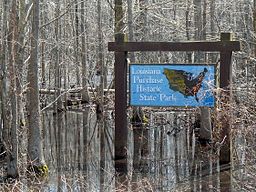Louisiana Purchase State Park
| Louisiana Purchase State Park | |
| Protected area | |
| Official name: Louisiana Purchase Historic State Park | |
| Name origin: Louisiana Purchase | |
| Country | |
|---|---|
| State | |
| Counties | Lee, Monroe, Phillips |
| Coordinates | 34°38′44.5″N 91°03′14.3″W / 34.645694°N 91.053972°WCoordinates: 34°38′44.5″N 91°03′14.3″W / 34.645694°N 91.053972°W |
| Area | 37.5 acres (15 ha) |
| Established | 1961 |
| - Added to NRHP | 1972 |
| - Designated NHL | 1993 |
| Management | Division of State Parks, Arkansas Department of Parks and Tourism |
| - location | Little Rock, Arkansas |
| - coordinates | 34°44′50.491″N 92°17′26.284″W / 34.74735861°N 92.29063444°W |
| Website: Louisiana Purchase State Park | |
The Louisiana Purchase State Park commemorates the initial point from which land surveys of the U.S. territory acquired through the Louisiana Purchase (1803) were surveyed. It encompasses 37.5 acres (15.2 ha) of swampland, a landform which is regionally in decline due to agricultural development practices. In the center is a 6-foot (1.8 m) marker erected on the survey point by the L'Anguille Chapter, Daughters of the American Revolution, in 1926. The site was listed on the National Register of Historic Places (1972) and designated a National Historic Landmark (1993).
The historic state park is located at the eastern end of Arkansas Highway 362, southeast of Blackton, Arkansas, at the tripoint junction of Lee, Monroe, and Phillips counties. It is a 37.5-acre (15.2 ha) parcel of swampland, which is remarkably unchanged from the time when surveyors came here in 1815. This type of swampland is becoming increasingly rare because of the practice of draining and clearing them for agricultural use. The boardwalk, 950 feet (290 m) long, leads to the site of the marker, with occasional interpretive signs describing the ecology of the area and the significance of the monument.
The Louisiana Purchase Survey Marker is 6 feet (1.8 m) in height and is about 4.5 feet (1.4 m) wide at the base. It typically stands in about 1 foot (0.30 m) of swamp water. The inscription reads: "This stone marks the base established November 10, 1815, from which the lands of the Louisiana Purchase were surveyed by United States engineers. The first survey from this point was made to satisfy the claims of the soldiers of the War of 1812 with land bounties".
On April 30, 1803, negotiators for the United States and the First French Empire, signed the Louisiana Purchase agreement, by which the United States acquired 830,000 square miles (2,100,000 km2) of land west of the Mississippi River, doubling its size. President James Monroe ordered a survey of the territory in 1815, in order to permit the orderly award of land in the territory to military veterans of the War of 1812. Prospect K. Robbins and Joseph C. Brown were commissioned to identify a starting point for the survey work in what is now eastern Arkansas. The team led by Robbins traveled north from the mouth of the Arkansas River, while that of Brown traveled west from the mouth of the St. Francis River. On October 27, 1815, Robbins' party crossed the east-west line laid down by Brown's party at this point, formally establishing the Fifth Principal Meridian. The 55 miles (89 km) of land Robbins traversed is even today some of the most difficult terrain in the state to negotiate. Brown's party traversed 26 miles (42 km) of land alternately described as "good for farming" and containing "briers and thickets in abundance". Brown's party eventually surveyed as far west as present-day Little Rock, while Robbins continued north to the Missouri River. Two trees near the site were blazed to mark the meeting point of the two survey lines.
...
Wikipedia

